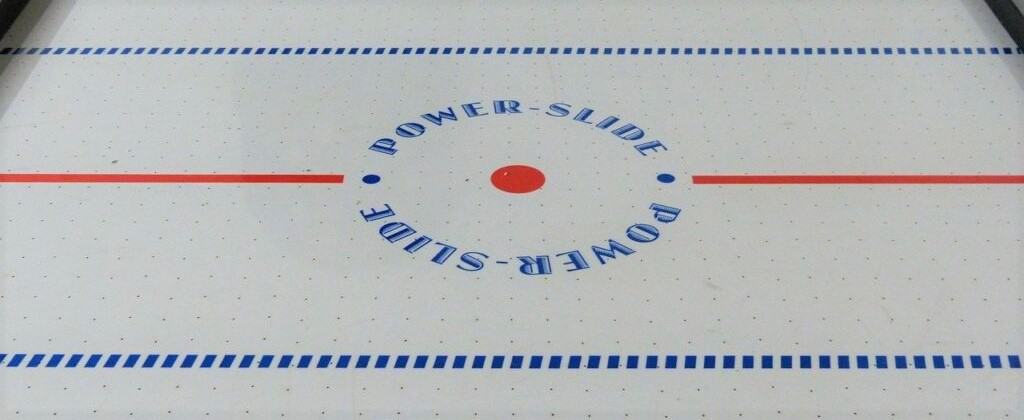Air hockey tables have become hugely popular in a variety of venues and they come in plenty of different sizes and forms to suit different budgets, but what are they made of? And what materials are best for an air hockey table? In this article, I’ll take you through all the main materials used to make an air hockey table.
The Quick Answer
Air hockey tables can be made from either wood, metal or plastic. The playing surface of the air hockey table is usually made from laminated plastic or stainless steel. The frame and rails are usually made from MDF on cheaper indoor tables, and either plastic or metal on outdoor and high-end tables.
| Air Hockey Table Component | Materials Used |
| Playing Surface | Plastic (PVC, polycarbonate, and methacrylate) and stainless steel |
| Frame and Rails | MDF, plastic (PVC and polycarbonate), stainless steel and solid wood |
| Fan | Metal and plastic |
| Puck | Lexan polycarbonate resin or nylon |
| Mallet | Plastic |

Playing Surface
Air hockey table playing surfaces can be made from thermoplastic or metal.
Most air hockey tables have a PVC laminated playing surface. PVC standard for polyvinyl chloride and it is a synthetic plastic polymer which is used in a variety of applications including the construction of doors and windows. It has a high hardness rating and strength to give it a rigid feel which is ideal for air hockey playing surfaces.
Some air hockey tables have a methacrylate playing surface which is similar to a bowling lane. The methacrylate coats a wooden surface to make sure it is completely flat and hard and provides plenty of speed and durability. Methacrylate is another polymer plastic but tends to offer a faster and more durable surface than PVC so is commonly used for commercial-grade tables.
Another common playing surface material is metal, and most commonly it is stainless steel which is used. This is the material of choice for high-end and commercial tables because it is very resistant and durable.
Outdoor air hockey tables typically have a polycarbonate playing surface which is similar to PVC but the polymer is composed of a carbon group instead of a chloride group.
No matter what the playing surface material is, they will all have tiny perforations in the surface to allow air to be pushed through them by the fan underneath. This allows the puck to sit on the cushion of air and move without any friction-resistance from the table.
Hence, the material of the playing surface does not make a huge difference in terms of the speed of the puck and the way the game feels, but it will make a difference to how your mallet (aka striker or pusher) moves on the table, and how durable it is.
Frame and Rails
Air hockey tables usually have either a wooden, metal or plastic frame and rails.
Cheaper air hockey tables designed for indoor use only, will usually have an MDF frame. MDF stands for medium-density fibreboard and is made by breaking down wood into fibres and then combining it with wax and resin to form panels using high levels of heat and pressure. MDF is inexpensive and lightweight which makes the table easy to transport.
The disadvantage of MDF is that it is not resistant to moisture. MDF tables cannot be used or stored outdoors because they cannot get wet, and they also should not be kept in humid environments. MDF will expand in humid conditions and will absorb water which can cause the frame to warp.
Plastic frames made from polycarbonate or PVC are more weather-resistant so can be used for indoor and outdoor tables. They’re lightweight and durable, making them a popular option.
Stainless steel frames and rails are seen on high-end tables and provide the best weather-resistance and also the most expensive look and feel. The only issue with metal frames is that they are much heavier than MDF and plastic, making it difficult to move the table once it has been installed.
Some air hockey tables may have a solid wooden frame which gives them a sophisticated design. Like with MDF, these are susceptible to high-humidity so will only be used on indoor tables and they are also quite heavy. Solid wood frames are quite rare and only seen on high-end air hockey tables.
Considering getting an air hockey table? Check out my guide to how much space you need for air hockey to make sure you get the right size table.
Internal Components
As I mentioned earlier, air hockey tables all have a fan underneath the playing surface which pushes air through the holes and makes the puck sit on the cushion of air so it can move very quickly.
This is why the puck will move very slowly if the table is unplugged or turned off at the switch because there is no power to the fan and the puck will be moving on the table surface instead. The fans are typically made from metal and plastic.
Puck and Mallet Materials
Air hockey pucks are made from Lexan polycarbonate resin which is shatterproof and weather-resistant. Some cheaper air hockey pucks are made from nylon which is cheaper but much lower-quality and feels softer making the game slightly slower. The plastic is usually red but can be any colour. Popular choices include black, white and orange. When selecting the colour, make sure you choose something which contrasts with the table.
Air hockey mallets, also known as strikers or pushes are made from plastic and have a velvet layer underneath which allows them to glide over the playing surface more easily and quickly. They come in a variety of colours, the most common being blue and red.
Here are some more articles you might find useful: